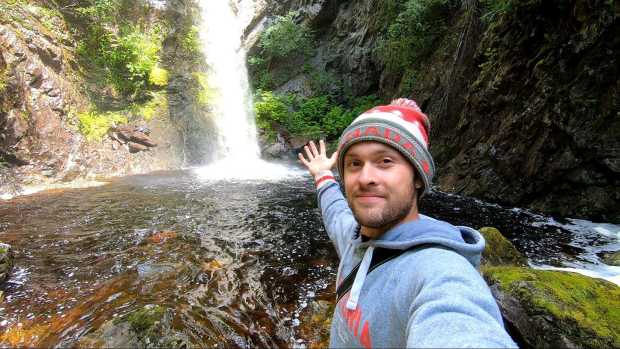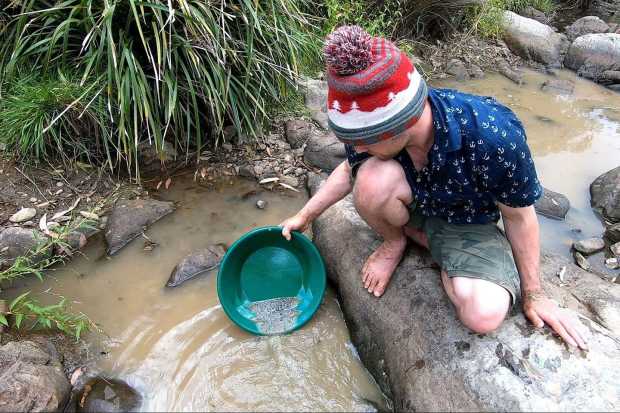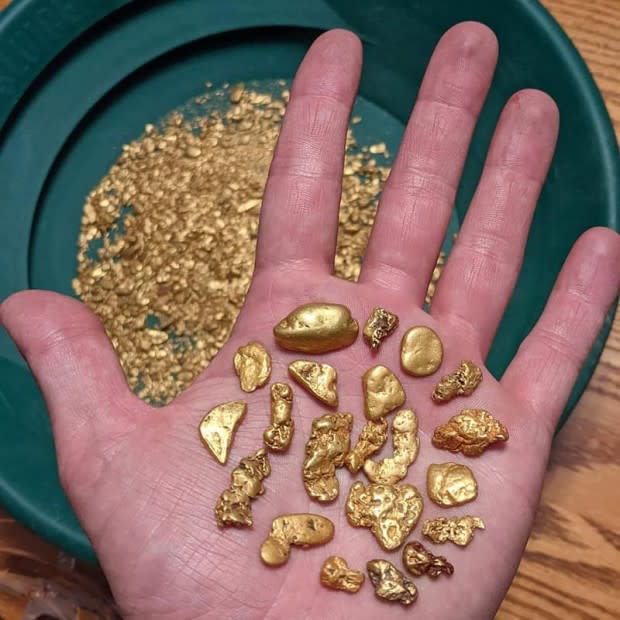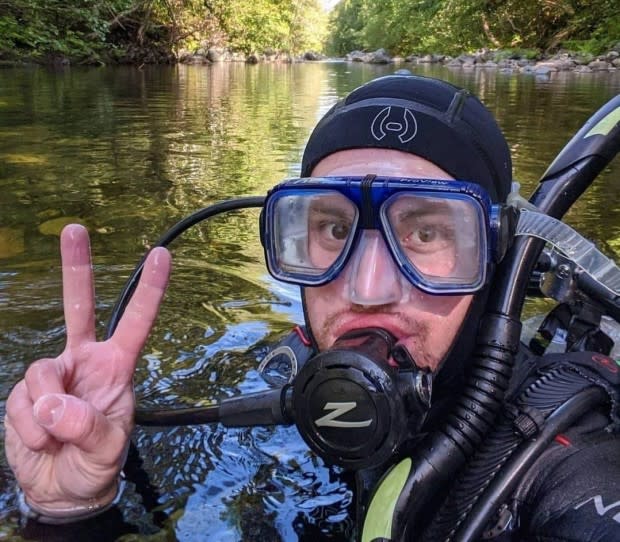I Quit My Job to Hunt for Gold. This Is What I've Learned.
On a sunny day this past January, Pauly Larouche was floating face down in a creek in a remote New Zealand forest. He was thousands of miles from home, and he and two guides had trekked for hours to get to this particular spot. They were drawn there by the same force that had lured prospectors in centuries past: Gold waiting to be discovered. Armed with a dive mask, a wetsuit, and hand tools, Larouche poked at rocks on the creek bed, searching for a hypnotic yellow shine.
In just ten minutes, he found his first nugget. And after two hours, he had picked up over 38 grams of gold, a haul worth thousands of dollars.
“I actually thought it was a prank,” says Larouche, but his guides were just as surprised as he was. He had uncovered something truly incredible. “It felt amazing,” he says.
Larouche, a native of Vancouver, Canada, has turned gold seeking into his full-time job. He travels the globe hunting for the precious metal, and he has over 540,000 subscribers on YouTube, where he posts videos of his exploits. Although most people think of gold hunting as a relic of the pioneer days (if they think about it at all), Larouche is proof there’s still treasure out to be found. In fact, thanks to the recent wet winter in California, amateur gold seekers across the Western U.S. are gearing up for a banner year. Heavy rains and snowmelt have sent soil cascading down rivers and creeks, exposing new gold for those willing to search for it. There are no guarantees in this business, but you might just get lucky, too. Larouche likes your odds.
“If those floods are loosening up ancient, untouched ground and pushing big boulders out of the way,” he says, “I would not be surprised.”
If you’re suddenly coming down with gold fever, read onward. Larouche told Men’s Journal about the different ways to practice his craft, his most intriguing discovery, and his advice for beginners who want to hunt for treasure of their own.

Pauly Larouche
Like to swim? Try gold sniping. Love gadgets? Metal detecting is for you.
The most common method, and the one you’re probably familiar with, is gold panning. Put a pan in a river or creek, fill it with silt and water, shake it up, and see what’s there. If you’re lucky, you’ll find gold. A panner can tell there’s gold at the bottom of the pan when a “super bright shine” emanates through the dark sand and grit, Larouche says.
“Gold is super heavy. It always sinks to the very, very bottom.”
But that’s far from the only way to find it. Other methods Larouche uses include sniping, where he dons a wetsuit and swims in a creek to access gold along the creek bottom (this is the method that led to his eye-popping discovery in New Zealand). He uses a snuffer bottle—a small sealed bottle with a straw that vacuums up sediment when squeezed—to suck up dirt, and any gold it might contain, from crevices and grooves in the rock.
Larouche has also tried sluicing, which involves setting up a sluice box in a creek. A sluice box is essentially a long chute with ripples and steps along its length. Creek water flows through it, and he’ll dump scoops of sediment into the box. Any gold in the dirt will settle to the bottom and get caught in the ripples of the sluice box. There’s also metal detection, like you might see an old guy doing at your local beach. By methodically scanning the ground with a metal detector, you can stumble on bits of gold.
“Gold is a very highly signaled metal,” Larouche says.
Larouche’s favorite method is called dredging, or “basically vacuuming in the river,” as he describes it. A dredge machine sucks up sediment and sifts it, revealing any gold caught in the muck. This mechanical approach allows him to work through bigger deposits of gravel than in a typical sniping search. It also reveals bedrock that “potentially has never been seen before.” This untouched sediment contains not just gold, but often artifacts like coins—some of which can be over a hundred years old.
The most important skill is patience.
Many first-time prospectors, Larouche says, will spend a few fruitless hours poking around with a metal detector. When they don’t find anything, they’ll give up and never try again. But prospecting is a long slog.
“More times than not, you’re gonna go out there, and you’re not gonna find anything,” he says.
You have to keep searching, even when the dirt seems devoid of any treasure. Find a bit of gold one time, and it gets easier to keep trying.
“Every trip out requires patience,” Larouche says. “It's kind of like fishing.”

Pauly Larouche
You need to be OK with pushing your limits.
Gold seeking tends to happen in secluded destinations: rugged mountain ranges, or wild creeks and rivers.
“You have to be pretty fit, because a lot of these locations are far away,” says Larouche, “and you have to be comfortable climbing over rocks, cliff faces, and mountains.”
Unsurprisingly, Larouche’s favorite trip to date was his successful expedition to New Zealand earlier this year. (The country has a long history with gold, including a major gold rush in the 1860s.) In addition to its potential for yielding treasure, Larouche was drawn to the country’s otherworldly beauty, but getting to his gold prospecting site was no easy task.
“It takes hours to get out there by car, and then you’ve gotta hike another hour or so to get into the location.”
The real fun began when a helicopter met Larouche and his guides in the wilderness and dropped off a dredge, which they had to pull upstream through narrow canyons.
It paid off. Larouche found around seven ounces of gold in a month in New Zealand—his best haul ever. He doesn’t sell what he finds, but he estimates the discovery to be worth $13,000 to $17,000. Larouche now views New Zealand as his “number one choice for places to find gold.”
There’s gold all around.
Very few people can travel across the globe in search of gold—but you don’t have to. So where should you look first?
“The first place I would tell somebody to check is Google,” Larouche says.
There’s plenty of info online about where gold is, generally speaking. By poking around and learning about the history of gold mining in your region, you can find potential sites near where you live and begin your adventure with at least some chance of success.
Larouche offers this encouragement for anyone who wants to try gold seeking, despite naysayers who might argue (as he once did) that it’s an outdated waste of time: “A lot of people say, ‘The gold’s not there anymore. The Gold Rush guys found the gold.’ But they were always going to the next best place, and they never really finished a spot,” he says. “Even if they did get all the gold, it replenishes with every flood. There’s always gold coming out of the hills.”

Pauly Larouche
Hunting for gold won’t make you rich—so find another reason to do it.
Larouche makes his living looking for gold, but not in the way you might expect. He earns a living from his YouTube channel; his measure of success isn’t the amount of gold he finds, but the number of views he racks up while searching for it. In his opinion, a person independently looking for gold would struggle to find enough metal to make ends meet.
Cashing out a mother lode isn’t Larouche’s goal. He just enjoys the search.
“The gold I find, I’ll keep,” Larouche says.
Some of it lives in a jar at home, some he keeps in a safe deposit box. He has no plans to sell any of it.
“It’s just the adventure. Going out there and challenging myself is why I like to keep doing it.”
Gold seeking can even be therapeutic. Larouche has dealt with panic attacks and anxiety throughout his life. Before he became a globetrotting prospector, he sometimes had a hard time leaving the house. That all started to change in 2016, when his cousin suggested they go looking for gold at the Sooke Potholes, a picturesque stretch of glacier-carved rock pools along the Sooke River on Vancouver Island. Larouche had never tried gold seeking before, but discovering his first few pieces was a powerful experience.
“I was absolutely hooked,” he says.
He started gold hunting more frequently. He also began posting videos of his experiences in the wild, and he quickly gained a following of viewers eager to see his treasure hunting adventures. Over time, his hunts became more ambitious. Larouche initially set out to find gold; in the process, he found his calling.
“I just started realizing, ‘I’m actually going out and gold panning and making videos, and I’m not even thinking of my problems, because now I’m doing it for someone else,’” Larouche explains. “It gave me a purpose.”

Pauly Larouche
Be prepared for the wilderness, and head home before you get too fatigued.
Dangers lurk when looking for gold in remote places. They’re the same ones you’d encounter on a hike or a camping trip: Bears, cougars, steep cliffs, dense forests, and cold temperatures all make Larouche’s list of things to watch out for.
But the most harrowing danger Larouche has faced didn’t come from wildlife or bad weather—it was the gold-bearing river itself. In 2021, Larouche was scuba diving in a river with a “semi-strong current.” He was getting tired, and suddenly the current overwhelmed him and sucked his scuba regulator right out of his mouth. He went into what he describes as a full-on panic attack. He started sucking in water. At that moment, Larouche felt he was about to die.
“While I surrendered in my mind, my body kept fighting,” he says. “I eventually got myself out and started throwing up the water I swallowed and inhaled.”
